Comprehensive Study: Leadership Style and UK Organisation Performance
VerifiedAdded on 2023/01/13
|20
|4049
|77
Report
AI Summary
This report investigates the impact of leadership styles on the performance of UK organizations. It begins with an introduction that defines leadership and its importance in the business context, followed by a background on organizational objectives and the factors that influence performance. The research problem is identified as the need to understand how leadership styles affect organizational outcomes. The objectives include identifying the influence of transformational and transactional leadership, and determining the impact of leadership behaviors. The literature review explores leadership styles, organizational performance, and their relationship. The methodology section outlines the research methods, design, target population, sample size, data collection, and analysis techniques, including descriptive research and semi-structured questionnaires. The study aims to contribute to the understanding of leadership's role in organizational success, providing insights for business leaders and researchers. The report also includes a conceptual framework, hypotheses, and considerations for ethical conduct.
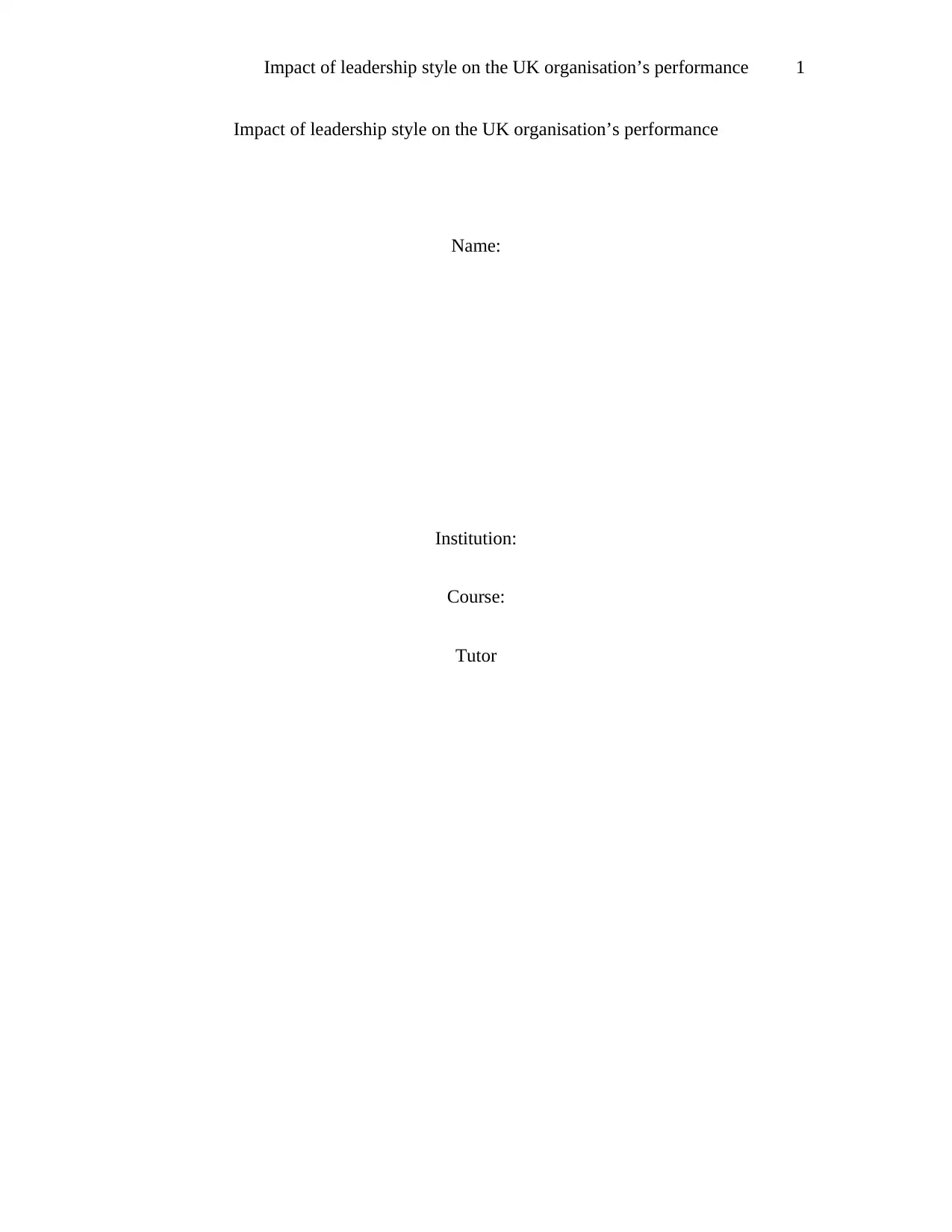
Impact of leadership style on the UK organisation’s performance 1
Impact of leadership style on the UK organisation’s performance
Name:
Institution:
Course:
Tutor
Impact of leadership style on the UK organisation’s performance
Name:
Institution:
Course:
Tutor
Paraphrase This Document
Need a fresh take? Get an instant paraphrase of this document with our AI Paraphraser
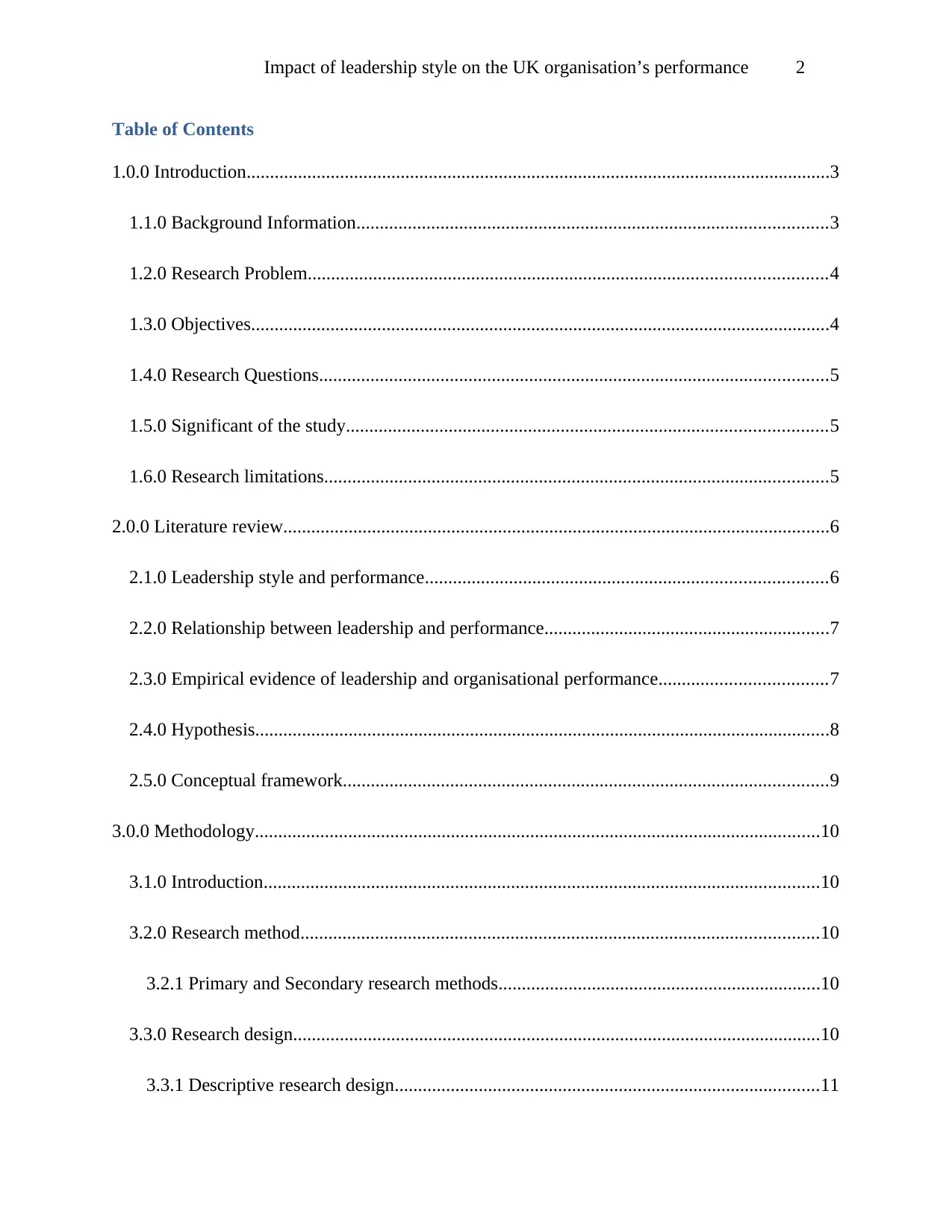
Impact of leadership style on the UK organisation’s performance 2
Table of Contents
1.0.0 Introduction.............................................................................................................................3
1.1.0 Background Information.....................................................................................................3
1.2.0 Research Problem...............................................................................................................4
1.3.0 Objectives............................................................................................................................4
1.4.0 Research Questions.............................................................................................................5
1.5.0 Significant of the study.......................................................................................................5
1.6.0 Research limitations............................................................................................................5
2.0.0 Literature review.....................................................................................................................6
2.1.0 Leadership style and performance......................................................................................6
2.2.0 Relationship between leadership and performance.............................................................7
2.3.0 Empirical evidence of leadership and organisational performance....................................7
2.4.0 Hypothesis...........................................................................................................................8
2.5.0 Conceptual framework........................................................................................................9
3.0.0 Methodology.........................................................................................................................10
3.1.0 Introduction.......................................................................................................................10
3.2.0 Research method...............................................................................................................10
3.2.1 Primary and Secondary research methods.....................................................................10
3.3.0 Research design.................................................................................................................10
3.3.1 Descriptive research design...........................................................................................11
Table of Contents
1.0.0 Introduction.............................................................................................................................3
1.1.0 Background Information.....................................................................................................3
1.2.0 Research Problem...............................................................................................................4
1.3.0 Objectives............................................................................................................................4
1.4.0 Research Questions.............................................................................................................5
1.5.0 Significant of the study.......................................................................................................5
1.6.0 Research limitations............................................................................................................5
2.0.0 Literature review.....................................................................................................................6
2.1.0 Leadership style and performance......................................................................................6
2.2.0 Relationship between leadership and performance.............................................................7
2.3.0 Empirical evidence of leadership and organisational performance....................................7
2.4.0 Hypothesis...........................................................................................................................8
2.5.0 Conceptual framework........................................................................................................9
3.0.0 Methodology.........................................................................................................................10
3.1.0 Introduction.......................................................................................................................10
3.2.0 Research method...............................................................................................................10
3.2.1 Primary and Secondary research methods.....................................................................10
3.3.0 Research design.................................................................................................................10
3.3.1 Descriptive research design...........................................................................................11
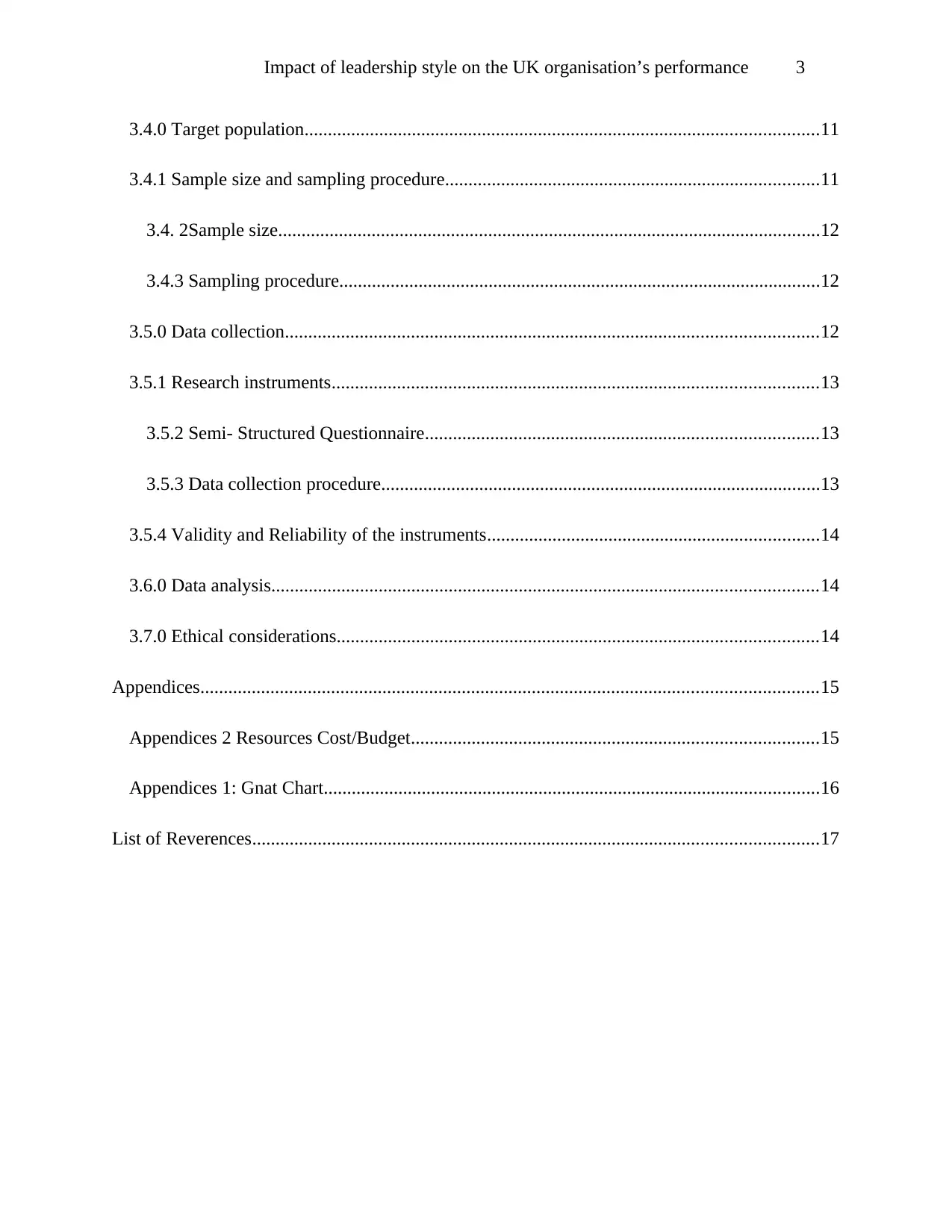
Impact of leadership style on the UK organisation’s performance 3
3.4.0 Target population..............................................................................................................11
3.4.1 Sample size and sampling procedure................................................................................11
3.4. 2Sample size....................................................................................................................12
3.4.3 Sampling procedure.......................................................................................................12
3.5.0 Data collection..................................................................................................................12
3.5.1 Research instruments........................................................................................................13
3.5.2 Semi- Structured Questionnaire....................................................................................13
3.5.3 Data collection procedure..............................................................................................13
3.5.4 Validity and Reliability of the instruments.......................................................................14
3.6.0 Data analysis.....................................................................................................................14
3.7.0 Ethical considerations.......................................................................................................14
Appendices....................................................................................................................................15
Appendices 2 Resources Cost/Budget.......................................................................................15
Appendices 1: Gnat Chart..........................................................................................................16
List of Reverences.........................................................................................................................17
3.4.0 Target population..............................................................................................................11
3.4.1 Sample size and sampling procedure................................................................................11
3.4. 2Sample size....................................................................................................................12
3.4.3 Sampling procedure.......................................................................................................12
3.5.0 Data collection..................................................................................................................12
3.5.1 Research instruments........................................................................................................13
3.5.2 Semi- Structured Questionnaire....................................................................................13
3.5.3 Data collection procedure..............................................................................................13
3.5.4 Validity and Reliability of the instruments.......................................................................14
3.6.0 Data analysis.....................................................................................................................14
3.7.0 Ethical considerations.......................................................................................................14
Appendices....................................................................................................................................15
Appendices 2 Resources Cost/Budget.......................................................................................15
Appendices 1: Gnat Chart..........................................................................................................16
List of Reverences.........................................................................................................................17
⊘ This is a preview!⊘
Do you want full access?
Subscribe today to unlock all pages.

Trusted by 1+ million students worldwide
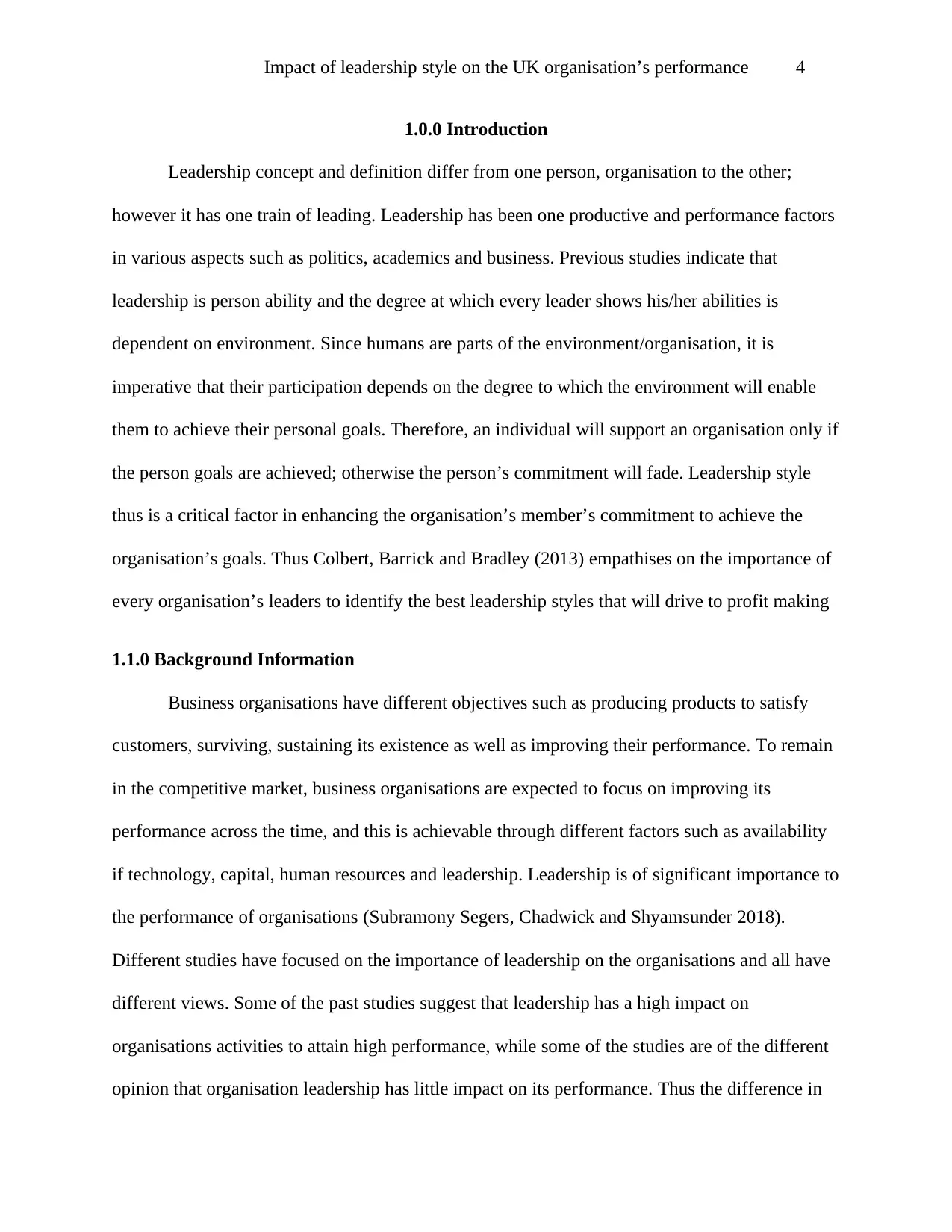
Impact of leadership style on the UK organisation’s performance 4
1.0.0 Introduction
Leadership concept and definition differ from one person, organisation to the other;
however it has one train of leading. Leadership has been one productive and performance factors
in various aspects such as politics, academics and business. Previous studies indicate that
leadership is person ability and the degree at which every leader shows his/her abilities is
dependent on environment. Since humans are parts of the environment/organisation, it is
imperative that their participation depends on the degree to which the environment will enable
them to achieve their personal goals. Therefore, an individual will support an organisation only if
the person goals are achieved; otherwise the person’s commitment will fade. Leadership style
thus is a critical factor in enhancing the organisation’s member’s commitment to achieve the
organisation’s goals. Thus Colbert, Barrick and Bradley (2013) empathises on the importance of
every organisation’s leaders to identify the best leadership styles that will drive to profit making
1.1.0 Background Information
Business organisations have different objectives such as producing products to satisfy
customers, surviving, sustaining its existence as well as improving their performance. To remain
in the competitive market, business organisations are expected to focus on improving its
performance across the time, and this is achievable through different factors such as availability
if technology, capital, human resources and leadership. Leadership is of significant importance to
the performance of organisations (Subramony Segers, Chadwick and Shyamsunder 2018).
Different studies have focused on the importance of leadership on the organisations and all have
different views. Some of the past studies suggest that leadership has a high impact on
organisations activities to attain high performance, while some of the studies are of the different
opinion that organisation leadership has little impact on its performance. Thus the difference in
1.0.0 Introduction
Leadership concept and definition differ from one person, organisation to the other;
however it has one train of leading. Leadership has been one productive and performance factors
in various aspects such as politics, academics and business. Previous studies indicate that
leadership is person ability and the degree at which every leader shows his/her abilities is
dependent on environment. Since humans are parts of the environment/organisation, it is
imperative that their participation depends on the degree to which the environment will enable
them to achieve their personal goals. Therefore, an individual will support an organisation only if
the person goals are achieved; otherwise the person’s commitment will fade. Leadership style
thus is a critical factor in enhancing the organisation’s member’s commitment to achieve the
organisation’s goals. Thus Colbert, Barrick and Bradley (2013) empathises on the importance of
every organisation’s leaders to identify the best leadership styles that will drive to profit making
1.1.0 Background Information
Business organisations have different objectives such as producing products to satisfy
customers, surviving, sustaining its existence as well as improving their performance. To remain
in the competitive market, business organisations are expected to focus on improving its
performance across the time, and this is achievable through different factors such as availability
if technology, capital, human resources and leadership. Leadership is of significant importance to
the performance of organisations (Subramony Segers, Chadwick and Shyamsunder 2018).
Different studies have focused on the importance of leadership on the organisations and all have
different views. Some of the past studies suggest that leadership has a high impact on
organisations activities to attain high performance, while some of the studies are of the different
opinion that organisation leadership has little impact on its performance. Thus the difference in
Paraphrase This Document
Need a fresh take? Get an instant paraphrase of this document with our AI Paraphraser
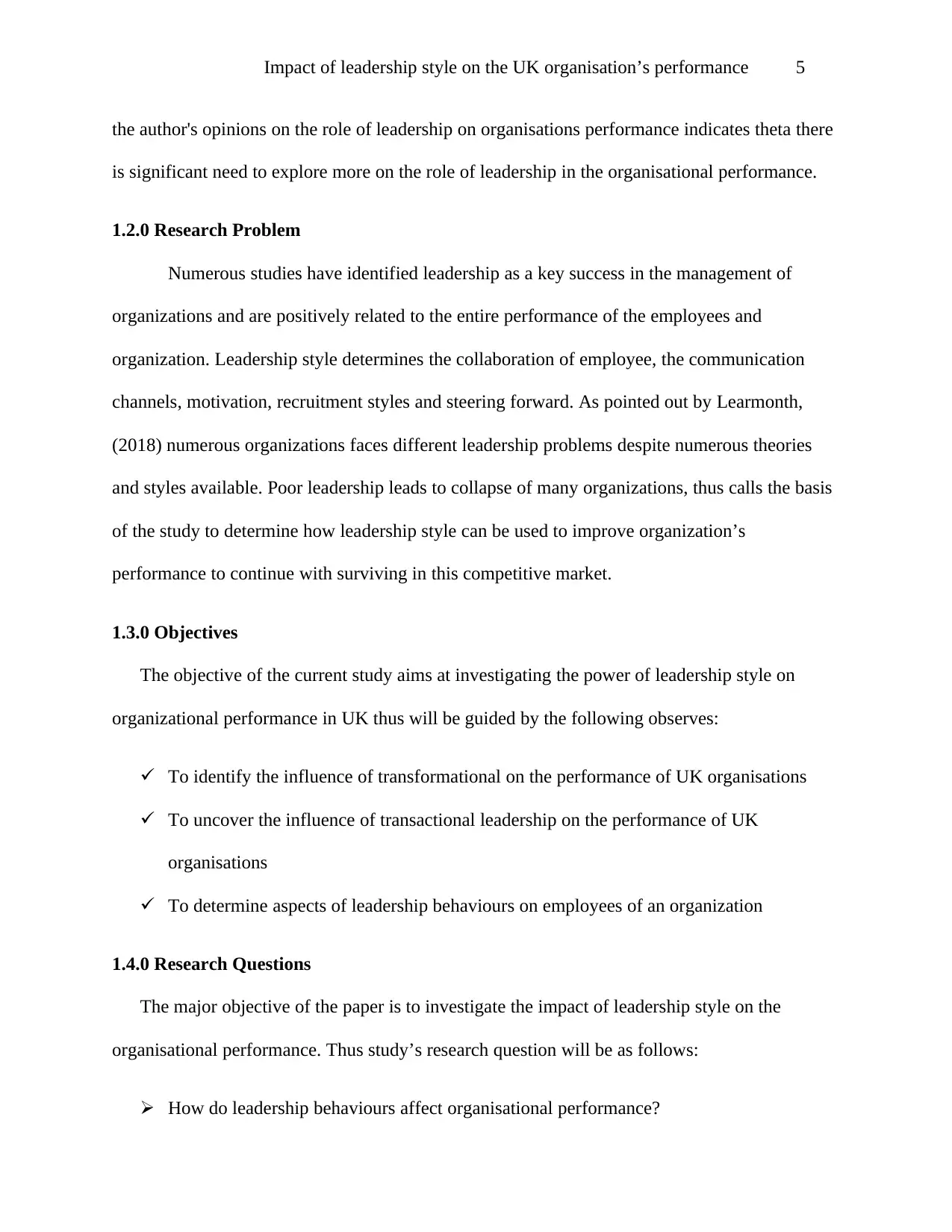
Impact of leadership style on the UK organisation’s performance 5
the author's opinions on the role of leadership on organisations performance indicates theta there
is significant need to explore more on the role of leadership in the organisational performance.
1.2.0 Research Problem
Numerous studies have identified leadership as a key success in the management of
organizations and are positively related to the entire performance of the employees and
organization. Leadership style determines the collaboration of employee, the communication
channels, motivation, recruitment styles and steering forward. As pointed out by Learmonth,
(2018) numerous organizations faces different leadership problems despite numerous theories
and styles available. Poor leadership leads to collapse of many organizations, thus calls the basis
of the study to determine how leadership style can be used to improve organization’s
performance to continue with surviving in this competitive market.
1.3.0 Objectives
The objective of the current study aims at investigating the power of leadership style on
organizational performance in UK thus will be guided by the following observes:
To identify the influence of transformational on the performance of UK organisations
To uncover the influence of transactional leadership on the performance of UK
organisations
To determine aspects of leadership behaviours on employees of an organization
1.4.0 Research Questions
The major objective of the paper is to investigate the impact of leadership style on the
organisational performance. Thus study’s research question will be as follows:
How do leadership behaviours affect organisational performance?
the author's opinions on the role of leadership on organisations performance indicates theta there
is significant need to explore more on the role of leadership in the organisational performance.
1.2.0 Research Problem
Numerous studies have identified leadership as a key success in the management of
organizations and are positively related to the entire performance of the employees and
organization. Leadership style determines the collaboration of employee, the communication
channels, motivation, recruitment styles and steering forward. As pointed out by Learmonth,
(2018) numerous organizations faces different leadership problems despite numerous theories
and styles available. Poor leadership leads to collapse of many organizations, thus calls the basis
of the study to determine how leadership style can be used to improve organization’s
performance to continue with surviving in this competitive market.
1.3.0 Objectives
The objective of the current study aims at investigating the power of leadership style on
organizational performance in UK thus will be guided by the following observes:
To identify the influence of transformational on the performance of UK organisations
To uncover the influence of transactional leadership on the performance of UK
organisations
To determine aspects of leadership behaviours on employees of an organization
1.4.0 Research Questions
The major objective of the paper is to investigate the impact of leadership style on the
organisational performance. Thus study’s research question will be as follows:
How do leadership behaviours affect organisational performance?
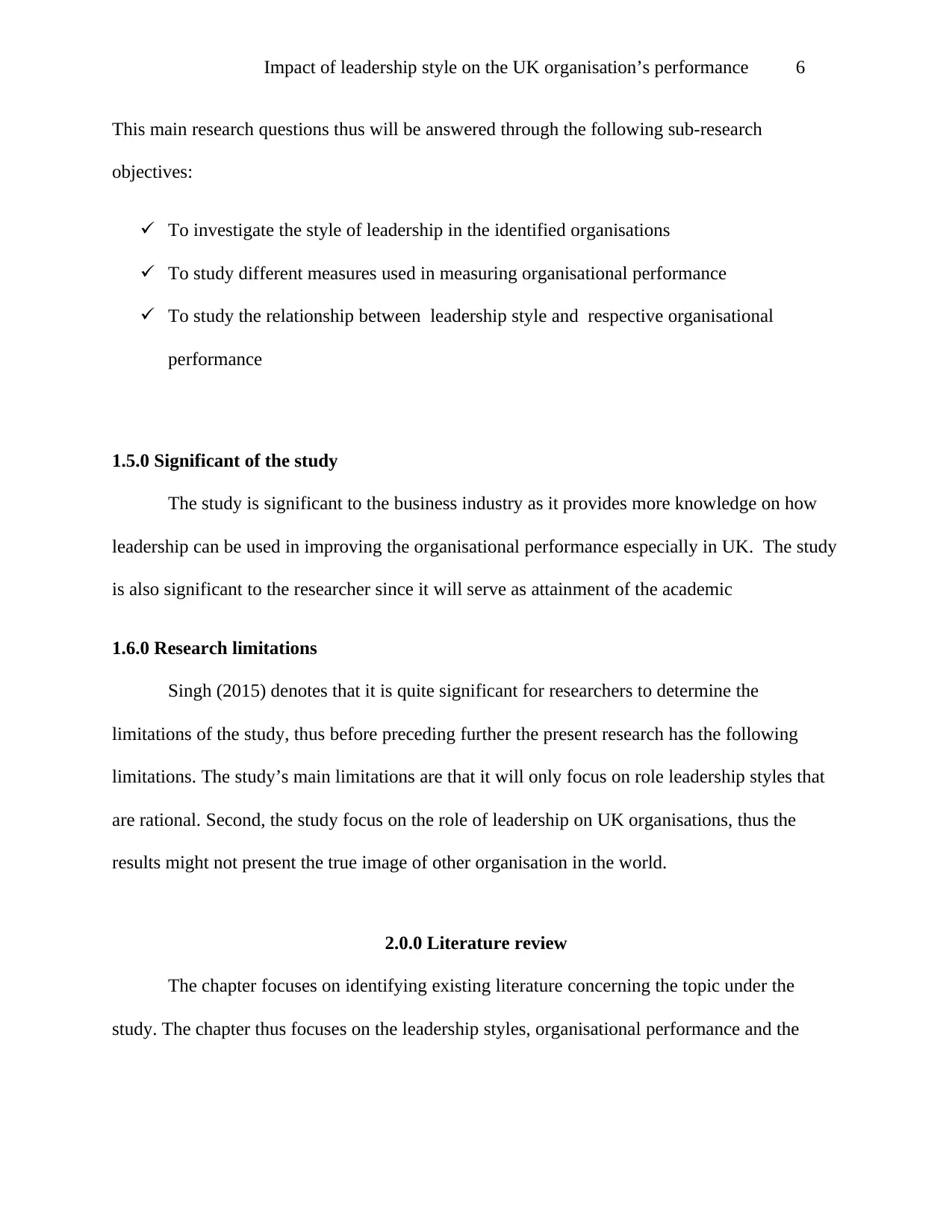
Impact of leadership style on the UK organisation’s performance 6
This main research questions thus will be answered through the following sub-research
objectives:
To investigate the style of leadership in the identified organisations
To study different measures used in measuring organisational performance
To study the relationship between leadership style and respective organisational
performance
1.5.0 Significant of the study
The study is significant to the business industry as it provides more knowledge on how
leadership can be used in improving the organisational performance especially in UK. The study
is also significant to the researcher since it will serve as attainment of the academic
1.6.0 Research limitations
Singh (2015) denotes that it is quite significant for researchers to determine the
limitations of the study, thus before preceding further the present research has the following
limitations. The study’s main limitations are that it will only focus on role leadership styles that
are rational. Second, the study focus on the role of leadership on UK organisations, thus the
results might not present the true image of other organisation in the world.
2.0.0 Literature review
The chapter focuses on identifying existing literature concerning the topic under the
study. The chapter thus focuses on the leadership styles, organisational performance and the
This main research questions thus will be answered through the following sub-research
objectives:
To investigate the style of leadership in the identified organisations
To study different measures used in measuring organisational performance
To study the relationship between leadership style and respective organisational
performance
1.5.0 Significant of the study
The study is significant to the business industry as it provides more knowledge on how
leadership can be used in improving the organisational performance especially in UK. The study
is also significant to the researcher since it will serve as attainment of the academic
1.6.0 Research limitations
Singh (2015) denotes that it is quite significant for researchers to determine the
limitations of the study, thus before preceding further the present research has the following
limitations. The study’s main limitations are that it will only focus on role leadership styles that
are rational. Second, the study focus on the role of leadership on UK organisations, thus the
results might not present the true image of other organisation in the world.
2.0.0 Literature review
The chapter focuses on identifying existing literature concerning the topic under the
study. The chapter thus focuses on the leadership styles, organisational performance and the
⊘ This is a preview!⊘
Do you want full access?
Subscribe today to unlock all pages.

Trusted by 1+ million students worldwide
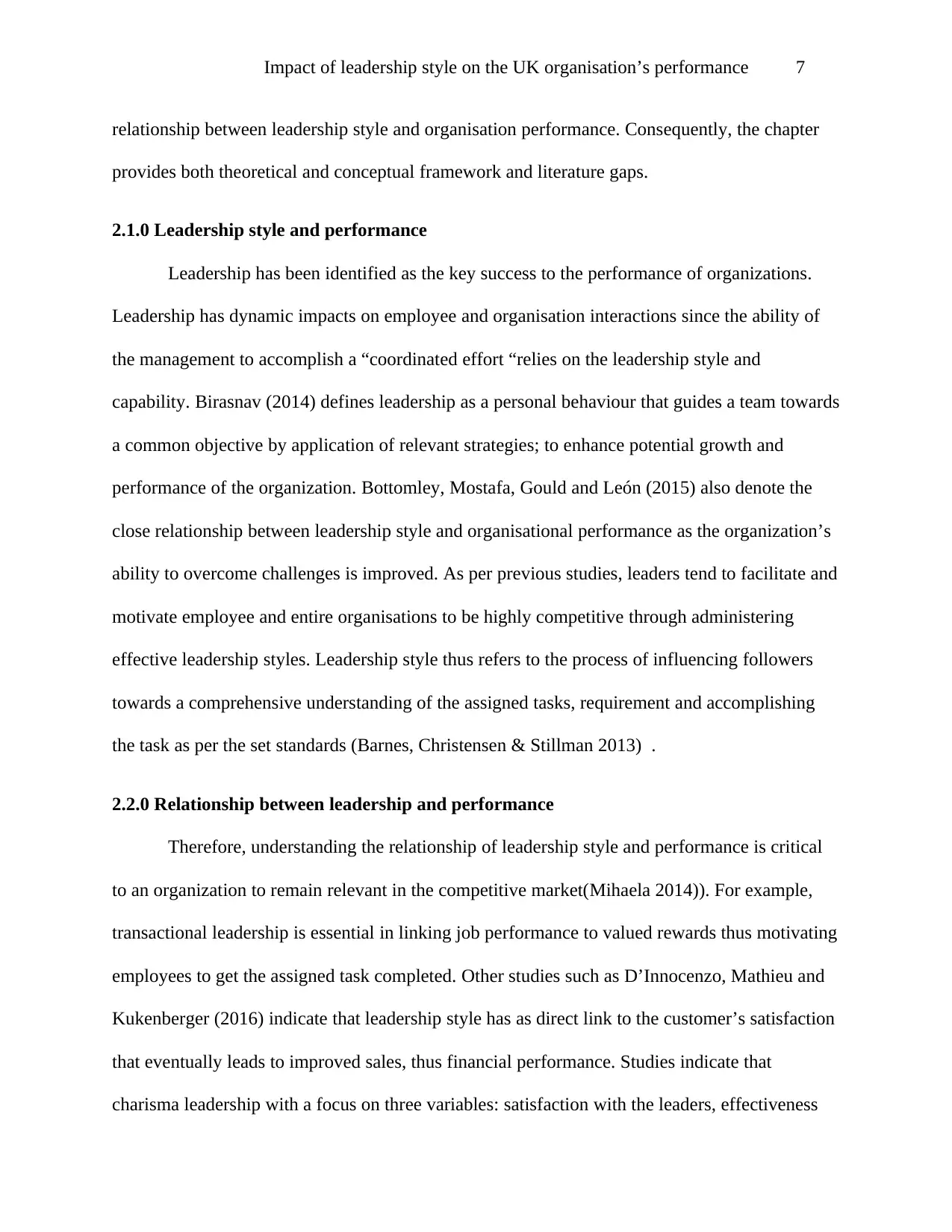
Impact of leadership style on the UK organisation’s performance 7
relationship between leadership style and organisation performance. Consequently, the chapter
provides both theoretical and conceptual framework and literature gaps.
2.1.0 Leadership style and performance
Leadership has been identified as the key success to the performance of organizations.
Leadership has dynamic impacts on employee and organisation interactions since the ability of
the management to accomplish a “coordinated effort “relies on the leadership style and
capability. Birasnav (2014) defines leadership as a personal behaviour that guides a team towards
a common objective by application of relevant strategies; to enhance potential growth and
performance of the organization. Bottomley, Mostafa, Gould and León (2015) also denote the
close relationship between leadership style and organisational performance as the organization’s
ability to overcome challenges is improved. As per previous studies, leaders tend to facilitate and
motivate employee and entire organisations to be highly competitive through administering
effective leadership styles. Leadership style thus refers to the process of influencing followers
towards a comprehensive understanding of the assigned tasks, requirement and accomplishing
the task as per the set standards (Barnes, Christensen & Stillman 2013) .
2.2.0 Relationship between leadership and performance
Therefore, understanding the relationship of leadership style and performance is critical
to an organization to remain relevant in the competitive market(Mihaela 2014)). For example,
transactional leadership is essential in linking job performance to valued rewards thus motivating
employees to get the assigned task completed. Other studies such as D’Innocenzo, Mathieu and
Kukenberger (2016) indicate that leadership style has as direct link to the customer’s satisfaction
that eventually leads to improved sales, thus financial performance. Studies indicate that
charisma leadership with a focus on three variables: satisfaction with the leaders, effectiveness
relationship between leadership style and organisation performance. Consequently, the chapter
provides both theoretical and conceptual framework and literature gaps.
2.1.0 Leadership style and performance
Leadership has been identified as the key success to the performance of organizations.
Leadership has dynamic impacts on employee and organisation interactions since the ability of
the management to accomplish a “coordinated effort “relies on the leadership style and
capability. Birasnav (2014) defines leadership as a personal behaviour that guides a team towards
a common objective by application of relevant strategies; to enhance potential growth and
performance of the organization. Bottomley, Mostafa, Gould and León (2015) also denote the
close relationship between leadership style and organisational performance as the organization’s
ability to overcome challenges is improved. As per previous studies, leaders tend to facilitate and
motivate employee and entire organisations to be highly competitive through administering
effective leadership styles. Leadership style thus refers to the process of influencing followers
towards a comprehensive understanding of the assigned tasks, requirement and accomplishing
the task as per the set standards (Barnes, Christensen & Stillman 2013) .
2.2.0 Relationship between leadership and performance
Therefore, understanding the relationship of leadership style and performance is critical
to an organization to remain relevant in the competitive market(Mihaela 2014)). For example,
transactional leadership is essential in linking job performance to valued rewards thus motivating
employees to get the assigned task completed. Other studies such as D’Innocenzo, Mathieu and
Kukenberger (2016) indicate that leadership style has as direct link to the customer’s satisfaction
that eventually leads to improved sales, thus financial performance. Studies indicate that
charisma leadership with a focus on three variables: satisfaction with the leaders, effectiveness
Paraphrase This Document
Need a fresh take? Get an instant paraphrase of this document with our AI Paraphraser
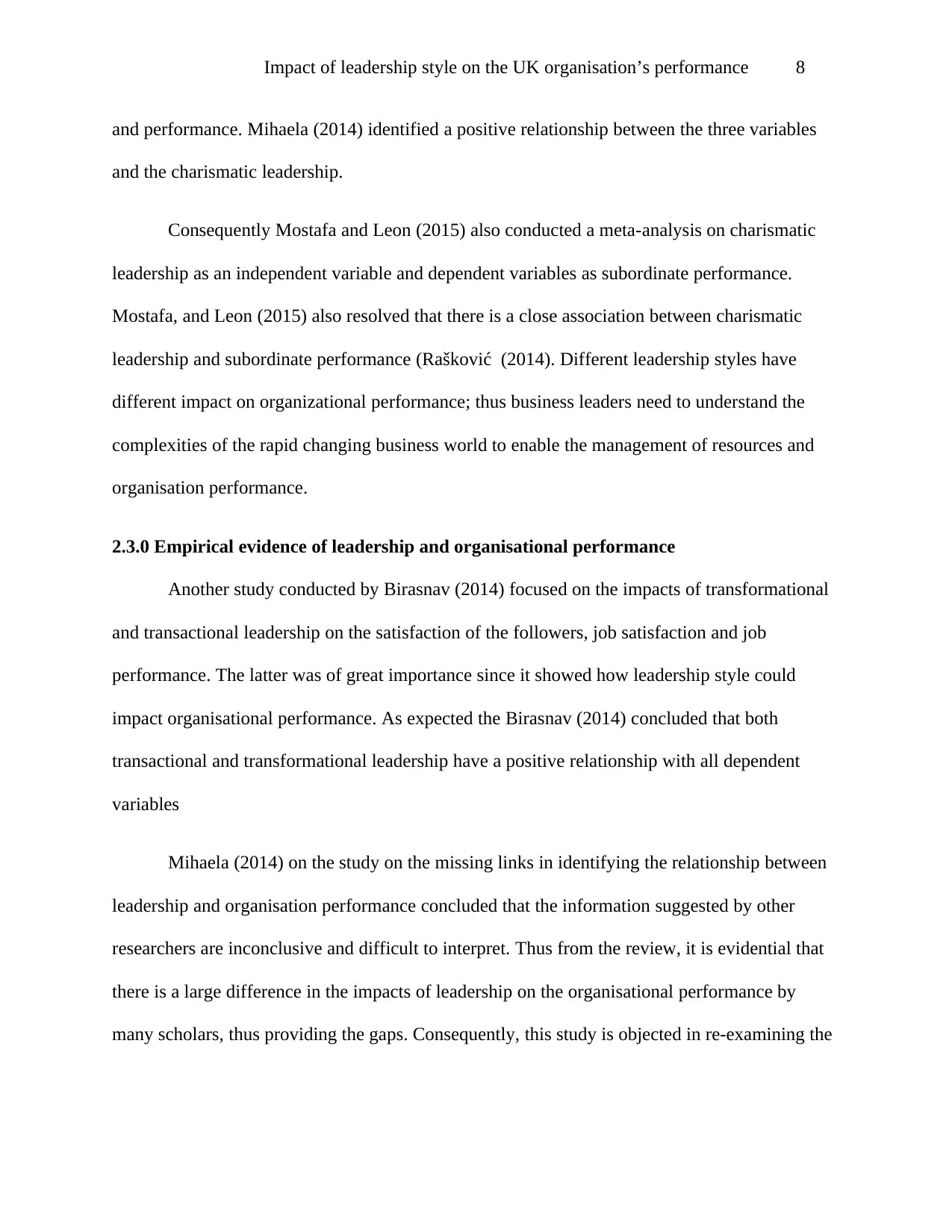
Impact of leadership style on the UK organisation’s performance 8
and performance. Mihaela (2014) identified a positive relationship between the three variables
and the charismatic leadership.
Consequently Mostafa and Leon (2015) also conducted a meta-analysis on charismatic
leadership as an independent variable and dependent variables as subordinate performance.
Mostafa, and Leon (2015) also resolved that there is a close association between charismatic
leadership and subordinate performance (Rašković (2014). Different leadership styles have
different impact on organizational performance; thus business leaders need to understand the
complexities of the rapid changing business world to enable the management of resources and
organisation performance.
2.3.0 Empirical evidence of leadership and organisational performance
Another study conducted by Birasnav (2014) focused on the impacts of transformational
and transactional leadership on the satisfaction of the followers, job satisfaction and job
performance. The latter was of great importance since it showed how leadership style could
impact organisational performance. As expected the Birasnav (2014) concluded that both
transactional and transformational leadership have a positive relationship with all dependent
variables
Mihaela (2014) on the study on the missing links in identifying the relationship between
leadership and organisation performance concluded that the information suggested by other
researchers are inconclusive and difficult to interpret. Thus from the review, it is evidential that
there is a large difference in the impacts of leadership on the organisational performance by
many scholars, thus providing the gaps. Consequently, this study is objected in re-examining the
and performance. Mihaela (2014) identified a positive relationship between the three variables
and the charismatic leadership.
Consequently Mostafa and Leon (2015) also conducted a meta-analysis on charismatic
leadership as an independent variable and dependent variables as subordinate performance.
Mostafa, and Leon (2015) also resolved that there is a close association between charismatic
leadership and subordinate performance (Rašković (2014). Different leadership styles have
different impact on organizational performance; thus business leaders need to understand the
complexities of the rapid changing business world to enable the management of resources and
organisation performance.
2.3.0 Empirical evidence of leadership and organisational performance
Another study conducted by Birasnav (2014) focused on the impacts of transformational
and transactional leadership on the satisfaction of the followers, job satisfaction and job
performance. The latter was of great importance since it showed how leadership style could
impact organisational performance. As expected the Birasnav (2014) concluded that both
transactional and transformational leadership have a positive relationship with all dependent
variables
Mihaela (2014) on the study on the missing links in identifying the relationship between
leadership and organisation performance concluded that the information suggested by other
researchers are inconclusive and difficult to interpret. Thus from the review, it is evidential that
there is a large difference in the impacts of leadership on the organisational performance by
many scholars, thus providing the gaps. Consequently, this study is objected in re-examining the
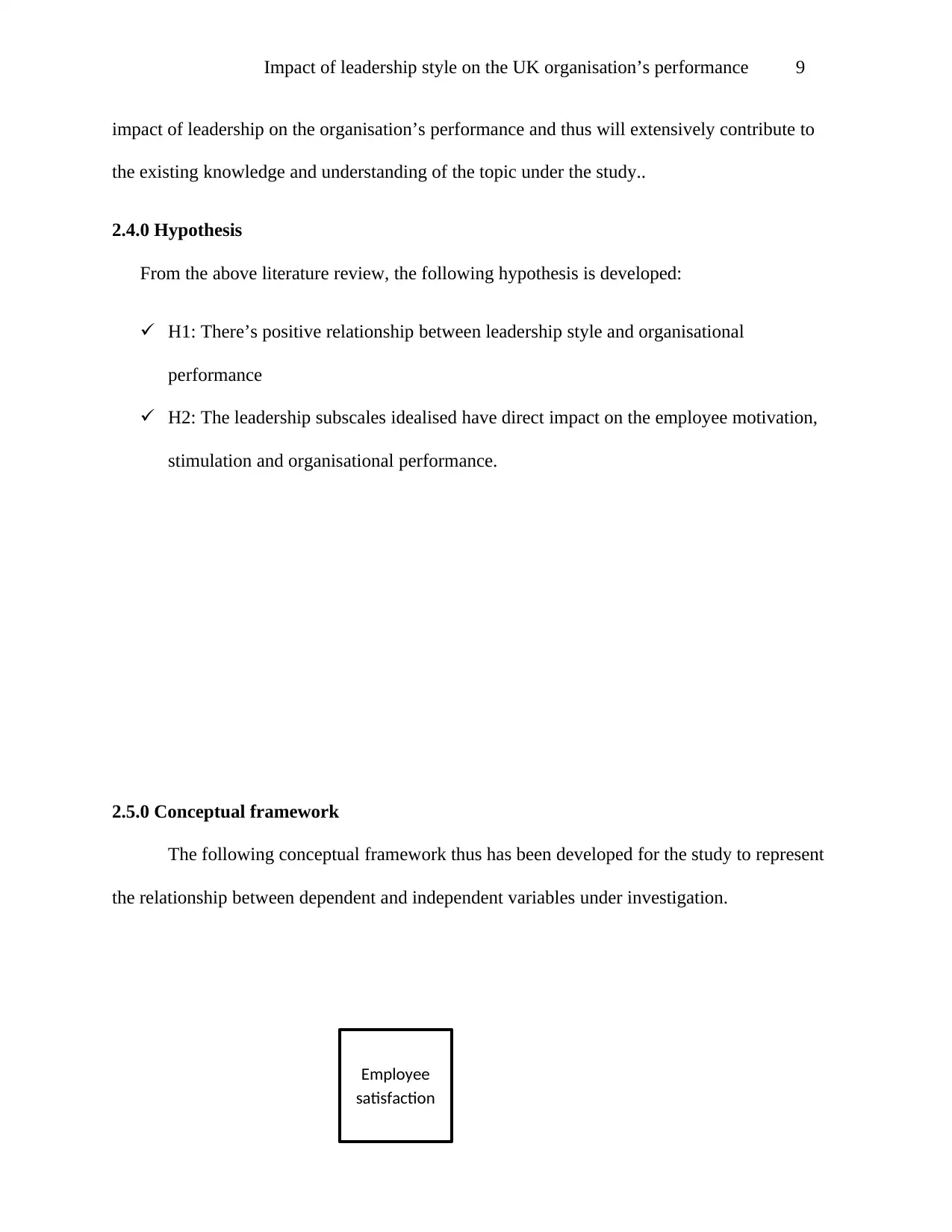
Impact of leadership style on the UK organisation’s performance 9
impact of leadership on the organisation’s performance and thus will extensively contribute to
the existing knowledge and understanding of the topic under the study..
2.4.0 Hypothesis
From the above literature review, the following hypothesis is developed:
H1: There’s positive relationship between leadership style and organisational
performance
H2: The leadership subscales idealised have direct impact on the employee motivation,
stimulation and organisational performance.
2.5.0 Conceptual framework
The following conceptual framework thus has been developed for the study to represent
the relationship between dependent and independent variables under investigation.
Employee
satisfaction
impact of leadership on the organisation’s performance and thus will extensively contribute to
the existing knowledge and understanding of the topic under the study..
2.4.0 Hypothesis
From the above literature review, the following hypothesis is developed:
H1: There’s positive relationship between leadership style and organisational
performance
H2: The leadership subscales idealised have direct impact on the employee motivation,
stimulation and organisational performance.
2.5.0 Conceptual framework
The following conceptual framework thus has been developed for the study to represent
the relationship between dependent and independent variables under investigation.
Employee
satisfaction
⊘ This is a preview!⊘
Do you want full access?
Subscribe today to unlock all pages.

Trusted by 1+ million students worldwide
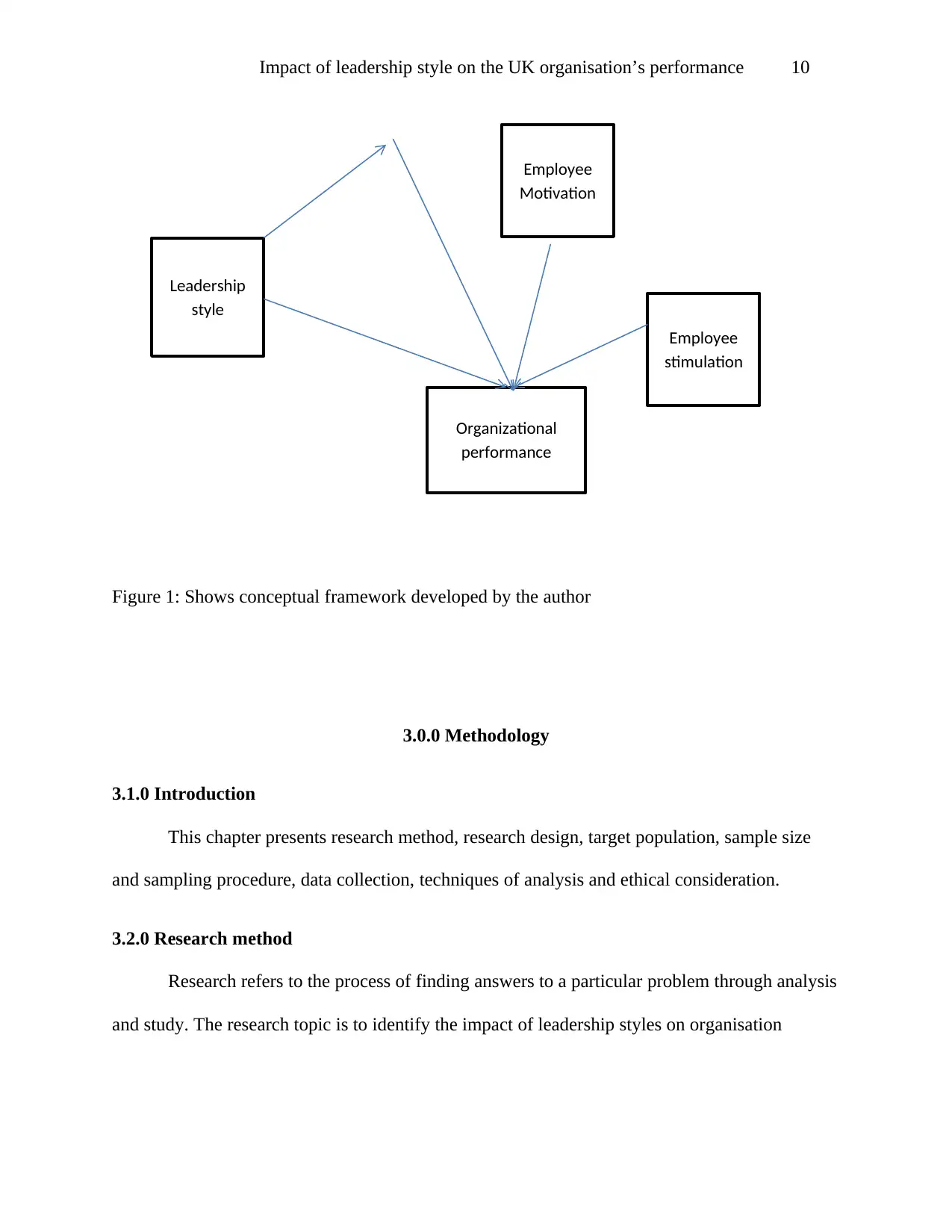
Impact of leadership style on the UK organisation’s performance 10
Figure 1: Shows conceptual framework developed by the author
3.0.0 Methodology
3.1.0 Introduction
This chapter presents research method, research design, target population, sample size
and sampling procedure, data collection, techniques of analysis and ethical consideration.
3.2.0 Research method
Research refers to the process of finding answers to a particular problem through analysis
and study. The research topic is to identify the impact of leadership styles on organisation
Employee
Motivation
Leadership
style
Employee
stimulation
Organizational
performance
Figure 1: Shows conceptual framework developed by the author
3.0.0 Methodology
3.1.0 Introduction
This chapter presents research method, research design, target population, sample size
and sampling procedure, data collection, techniques of analysis and ethical consideration.
3.2.0 Research method
Research refers to the process of finding answers to a particular problem through analysis
and study. The research topic is to identify the impact of leadership styles on organisation
Employee
Motivation
Leadership
style
Employee
stimulation
Organizational
performance
Paraphrase This Document
Need a fresh take? Get an instant paraphrase of this document with our AI Paraphraser
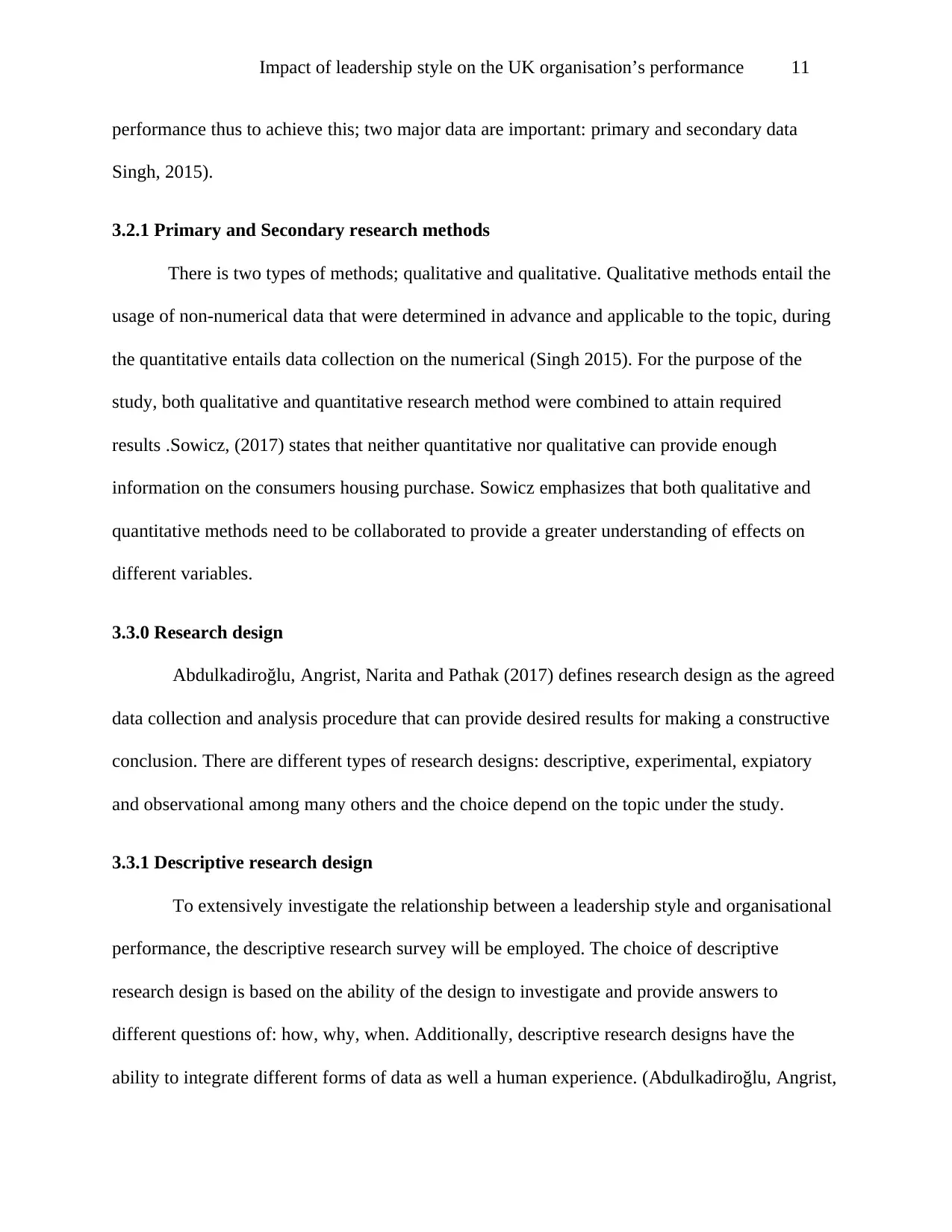
Impact of leadership style on the UK organisation’s performance 11
performance thus to achieve this; two major data are important: primary and secondary data
Singh, 2015).
3.2.1 Primary and Secondary research methods
There is two types of methods; qualitative and qualitative. Qualitative methods entail the
usage of non-numerical data that were determined in advance and applicable to the topic, during
the quantitative entails data collection on the numerical (Singh 2015). For the purpose of the
study, both qualitative and quantitative research method were combined to attain required
results .Sowicz, (2017) states that neither quantitative nor qualitative can provide enough
information on the consumers housing purchase. Sowicz emphasizes that both qualitative and
quantitative methods need to be collaborated to provide a greater understanding of effects on
different variables.
3.3.0 Research design
Abdulkadiroğlu, Angrist, Narita and Pathak (2017) defines research design as the agreed
data collection and analysis procedure that can provide desired results for making a constructive
conclusion. There are different types of research designs: descriptive, experimental, expiatory
and observational among many others and the choice depend on the topic under the study.
3.3.1 Descriptive research design
To extensively investigate the relationship between a leadership style and organisational
performance, the descriptive research survey will be employed. The choice of descriptive
research design is based on the ability of the design to investigate and provide answers to
different questions of: how, why, when. Additionally, descriptive research designs have the
ability to integrate different forms of data as well a human experience. (Abdulkadiroğlu, Angrist,
performance thus to achieve this; two major data are important: primary and secondary data
Singh, 2015).
3.2.1 Primary and Secondary research methods
There is two types of methods; qualitative and qualitative. Qualitative methods entail the
usage of non-numerical data that were determined in advance and applicable to the topic, during
the quantitative entails data collection on the numerical (Singh 2015). For the purpose of the
study, both qualitative and quantitative research method were combined to attain required
results .Sowicz, (2017) states that neither quantitative nor qualitative can provide enough
information on the consumers housing purchase. Sowicz emphasizes that both qualitative and
quantitative methods need to be collaborated to provide a greater understanding of effects on
different variables.
3.3.0 Research design
Abdulkadiroğlu, Angrist, Narita and Pathak (2017) defines research design as the agreed
data collection and analysis procedure that can provide desired results for making a constructive
conclusion. There are different types of research designs: descriptive, experimental, expiatory
and observational among many others and the choice depend on the topic under the study.
3.3.1 Descriptive research design
To extensively investigate the relationship between a leadership style and organisational
performance, the descriptive research survey will be employed. The choice of descriptive
research design is based on the ability of the design to investigate and provide answers to
different questions of: how, why, when. Additionally, descriptive research designs have the
ability to integrate different forms of data as well a human experience. (Abdulkadiroğlu, Angrist,
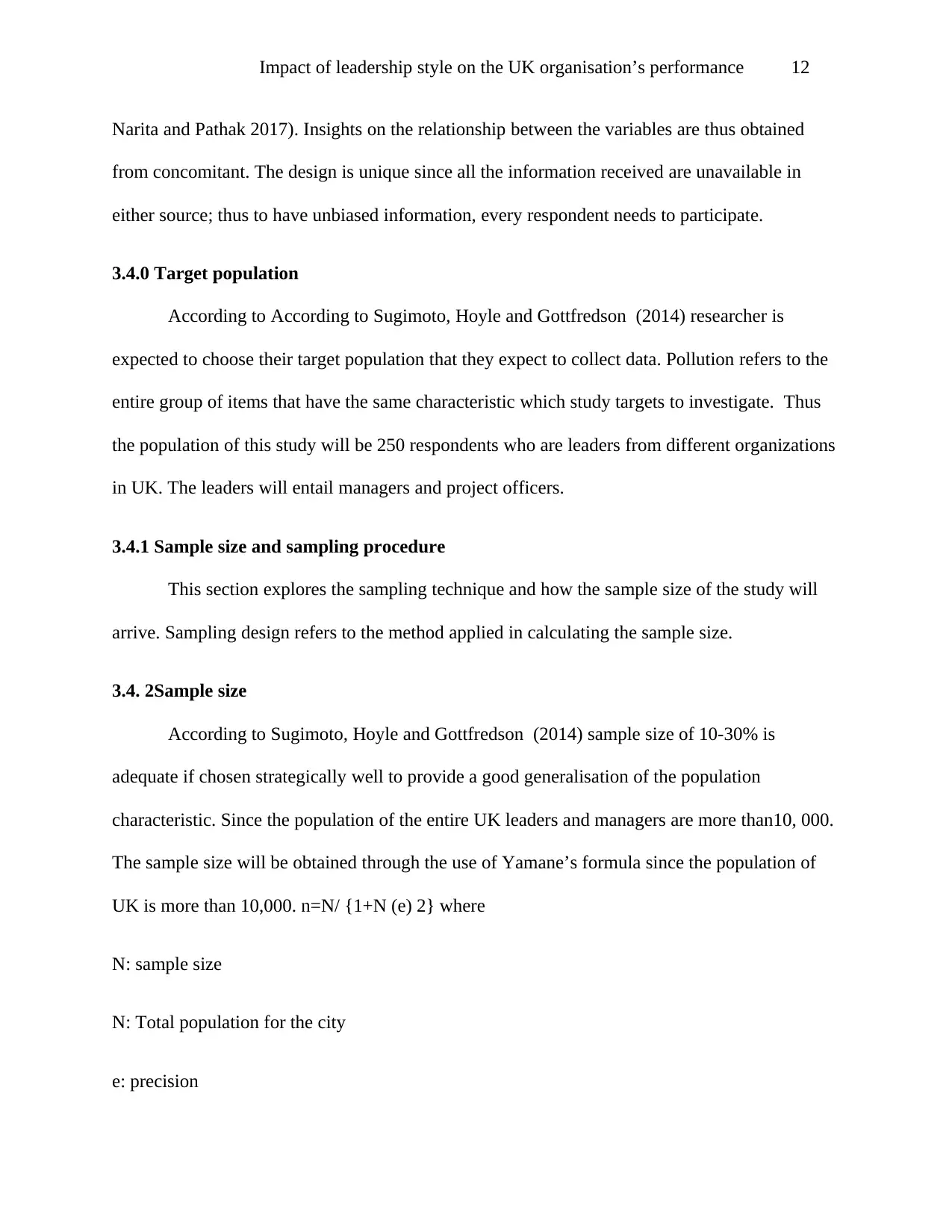
Impact of leadership style on the UK organisation’s performance 12
Narita and Pathak 2017). Insights on the relationship between the variables are thus obtained
from concomitant. The design is unique since all the information received are unavailable in
either source; thus to have unbiased information, every respondent needs to participate.
3.4.0 Target population
According to According to Sugimoto, Hoyle and Gottfredson (2014) researcher is
expected to choose their target population that they expect to collect data. Pollution refers to the
entire group of items that have the same characteristic which study targets to investigate. Thus
the population of this study will be 250 respondents who are leaders from different organizations
in UK. The leaders will entail managers and project officers.
3.4.1 Sample size and sampling procedure
This section explores the sampling technique and how the sample size of the study will
arrive. Sampling design refers to the method applied in calculating the sample size.
3.4. 2Sample size
According to Sugimoto, Hoyle and Gottfredson (2014) sample size of 10-30% is
adequate if chosen strategically well to provide a good generalisation of the population
characteristic. Since the population of the entire UK leaders and managers are more than10, 000.
The sample size will be obtained through the use of Yamane’s formula since the population of
UK is more than 10,000. n=N/ {1+N (e) 2} where
N: sample size
N: Total population for the city
e: precision
Narita and Pathak 2017). Insights on the relationship between the variables are thus obtained
from concomitant. The design is unique since all the information received are unavailable in
either source; thus to have unbiased information, every respondent needs to participate.
3.4.0 Target population
According to According to Sugimoto, Hoyle and Gottfredson (2014) researcher is
expected to choose their target population that they expect to collect data. Pollution refers to the
entire group of items that have the same characteristic which study targets to investigate. Thus
the population of this study will be 250 respondents who are leaders from different organizations
in UK. The leaders will entail managers and project officers.
3.4.1 Sample size and sampling procedure
This section explores the sampling technique and how the sample size of the study will
arrive. Sampling design refers to the method applied in calculating the sample size.
3.4. 2Sample size
According to Sugimoto, Hoyle and Gottfredson (2014) sample size of 10-30% is
adequate if chosen strategically well to provide a good generalisation of the population
characteristic. Since the population of the entire UK leaders and managers are more than10, 000.
The sample size will be obtained through the use of Yamane’s formula since the population of
UK is more than 10,000. n=N/ {1+N (e) 2} where
N: sample size
N: Total population for the city
e: precision
⊘ This is a preview!⊘
Do you want full access?
Subscribe today to unlock all pages.

Trusted by 1+ million students worldwide
1 out of 20
Related Documents
Your All-in-One AI-Powered Toolkit for Academic Success.
+13062052269
info@desklib.com
Available 24*7 on WhatsApp / Email
![[object Object]](/_next/static/media/star-bottom.7253800d.svg)
Unlock your academic potential
Copyright © 2020–2025 A2Z Services. All Rights Reserved. Developed and managed by ZUCOL.





